glove box Hyundai Accent 2003 Owner's Manual
[x] Cancel search | Manufacturer: HYUNDAI, Model Year: 2003, Model line: Accent, Model: Hyundai Accent 2003Pages: 186, PDF Size: 11.36 MB
Page 10 of 186
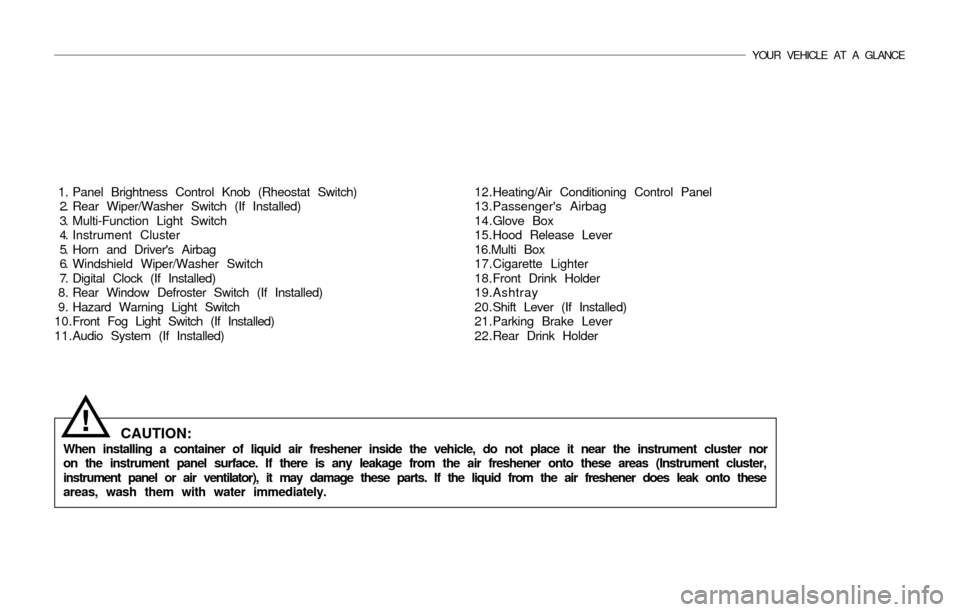
YOUR VEHICLE AT A GLANCE
1. Panel Brightness Control Knob (Rheostat Switch)
2. Rear Wiper/Washer Switch (If Installed)
3. Multi-Function Light Switch
4. Instrument Cluster
5. Horn and Driver's Airbag
6. Windshield Wiper/Washer Switch
7. Digital Clock (If Installed)
8. Rear Window Defroster Switch (If Installed)
9. Hazard Warning Light Switch
1 0 . Front Fog Light Switch (If Installed)
11.Audio System (If Installed)12.Heating/Air Conditioning Control Panel
13.Passenger's Airbag
14.Glove Box
15.Hood Release Lever
16.Multi Box
17.Cigarette Lighter
18.Front Drink Holder
19.Ashtray
20. Shift Lever (If Installed)
21.Parking Brake Lever
22.Rear Drink Holder
CAUTION:When installing a container of liquid air freshener inside the vehicle, do not place it near the instrument cluster nor
on the instrument panel surface. If there is any leakage from the air freshener onto these areas (Instrument cluster,
instrument panel or air ventilator), it may damage these parts. If the liquid from the air freshener does leak onto these
areas, wash them with water immediately.
!
Page 39 of 186
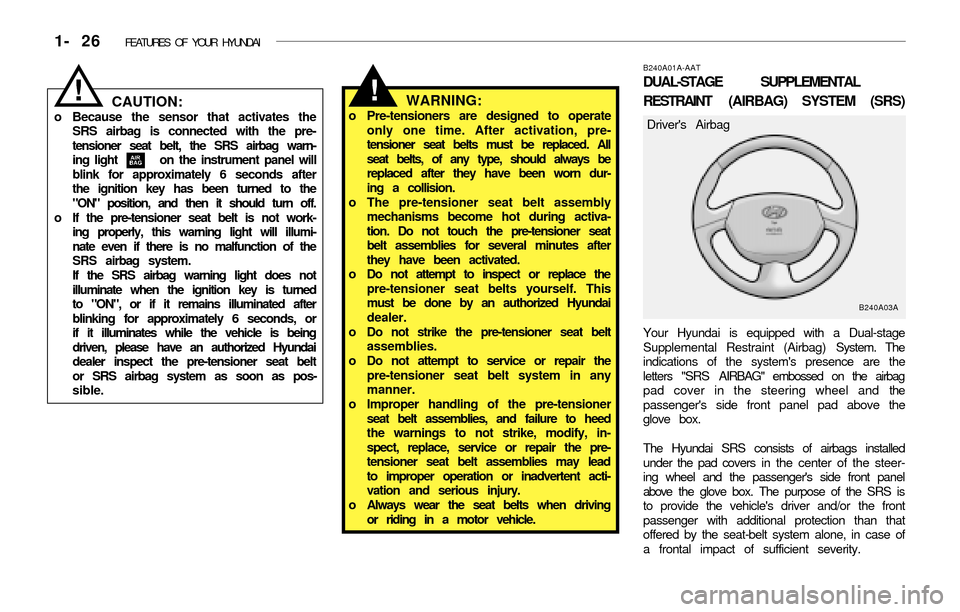
1- 26 FEATURES OF YOUR HYUNDAI
B240A01A-AAT
DUAL-STAGE SUPPLEMENTAL
RESTRAINT (AIRBAG) SYSTEM (SRS)
Your Hyundai is equipped with a Dual-stage
Supplemental Restraint (Airbag) System. The
indications of the system's presence are the
letters "SRS AIRBAG" embossed on the airbag
pad cover in the steering wheel and the
passenger's side front panel pad above the
glove box.
The Hyundai SRS consists of airbags installed
under the pad covers in the center of the steer-
ing wheel and the passenger's side front panel
above the glove box. The purpose of the SRS is
to provide the vehicle's driver and/or the front
passenger with additional protection than that
offered by the seat-belt system alone, in case of
a frontal impact of sufficient severity.
B240A03A
Driver's Airbag
WARNING:o Pre-tensioners are designed to operate
only one time. After activation, pre-
tensioner seat belts must be replaced. All
seat belts, of any type, should always be
replaced after they have been worn dur-
ing a collision.
o The pre-tensioner seat belt assembly
mechanisms become hot during activa-
tion. Do not touch the pre-tensioner seat
belt assemblies for several minutes after
they have been activated.
o Do not attempt to inspect or replace the
pre-tensioner seat belts yourself. This
must be done by an authorized Hyundai
dealer.
o Do not strike the pre-tensioner seat belt
assemblies.
o Do not attempt to service or repair the
pre-tensioner seat belt system in any
manner.
o Improper handling of the pre-tensioner
seat belt assemblies, and failure to heed
the warnings to not strike, modify, in-
spect, replace, service or repair the pre-
tensioner seat belt assemblies may lead
to improper operation or inadvertent acti-
vation and serious injury.
o Always wear the seat belts when driving
or riding in a motor vehicle.
!CAUTION:o Because the sensor that activates the
SRS airbag is connected with the pre-
tensioner seat belt, the SRS airbag warn-
ing light on the instrument panel will
blink for approximately 6 seconds after
the ignition key has been turned to the
"ON" position, and then it should turn off.
o If the pre-tensioner seat belt is not work-
ing properly, this warning light will illumi-
nate even if there is no malfunction of the
SRS airbag system.
If the SRS airbag warning light does not
illuminate when the ignition key is turned
to "ON", or if it remains illuminated after
blinking for approximately 6 seconds, or
if it illuminates while the vehicle is being
driven, please have an authorized Hyundai
dealer inspect the pre-tensioner seat belt
or SRS airbag system as soon as pos-
sible.
!
Page 40 of 186
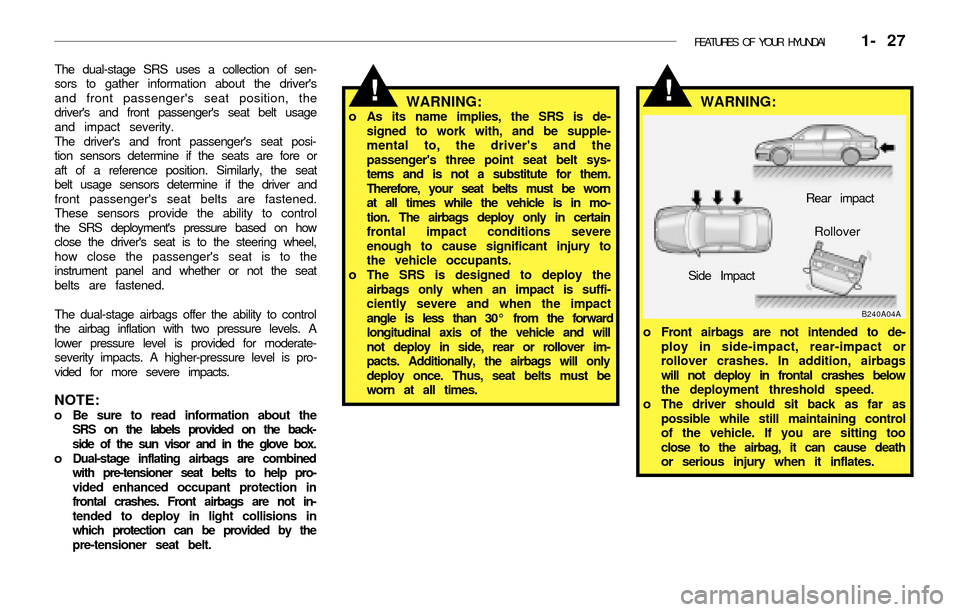
FEATURES OF YOUR HYUNDAI 1- 27
o Front airbags are not intended to de-
ploy in side-impact, rear-impact or
rollover crashes. In addition, airbags
will not deploy in frontal crashes below
the deployment threshold speed.
o The driver should sit back as far as
possible while still maintaining control
of the vehicle. If you are sitting too
close to the airbag, it can cause death
or serious injury when it inflates.
B240A04A
Rear impact
Side ImpactRollover
!
The dual-stage SRS uses a collection of sen-
sors to gather information about the driver's
and front passenger's seat position, the
driver's and front passenger's seat belt usage
and impact severity.
The driver's and front passenger's seat posi-
tion sensors determine if the seats are fore or
aft of a reference position. Similarly, the seat
belt usage sensors determine if the driver and
front passenger's seat belts are fastened.
These sensors provide the ability to control
the SRS deployment's pressure based on how
close the driver's seat is to the steering wheel,
how close the passenger's seat is to the
instrument panel and whether or not the seat
belts are fastened.
The dual-stage airbags offer the ability to control
the airbag inflation with two pressure levels. A
lower pressure level is provided for moderate-
severity impacts. A higher-pressure level is pro-
vided for more severe impacts.
NOTE:o Be sure to read information about the
SRS on the labels provided on the back-
side of the sun visor and in the glove box.
o Dual-stage inflating airbags are combined
with pre-tensioner seat belts to help pro-
vided enhanced occupant protection in
frontal crashes. Front airbags are not in-
tended to deploy in light collisions in
which protection can be provided by the
pre-tensioner seat belt.
WARNING:o As its name implies, the SRS is de-
signed to work with, and be supple-
mental to, the driver's and the
passenger's three point seat belt sys-
tems and is not a substitute for them.
Therefore, your seat belts must be worn
at all times while the vehicle is in mo-
tion. The airbags deploy only in certain
frontal impact conditions severe
enough to cause significant injury to
the vehicle occupants.
o The SRS is designed to deploy the
airbags only when an impact is suffi-
ciently severe and when the impact
angle is less than 30° from the forward
longitudinal axis of the vehicle and will
not deploy in side, rear or rollover im-
pacts. Additionally, the airbags will only
deploy once. Thus, seat belts must be
worn at all times.
!WARNING:
Page 41 of 186
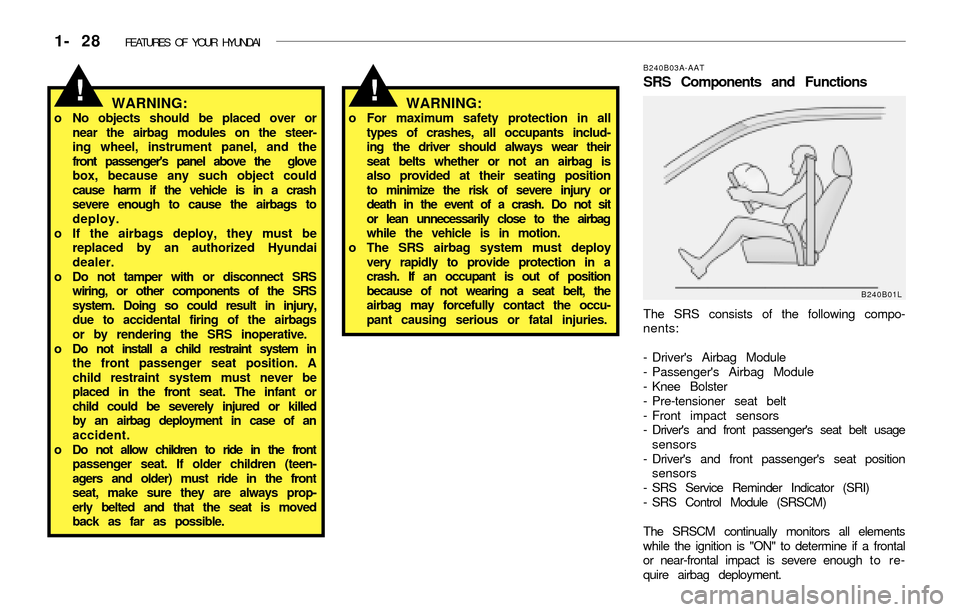
1- 28 FEATURES OF YOUR HYUNDAI
B240B03A-AAT
SRS Components and Functions
The SRS consists of the following compo-
nents:
- Driver's Airbag Module
- Passenger's Airbag Module
- Knee Bolster
- Pre-tensioner seat belt
- Front impact sensors
- Driver's and front passenger's seat belt usage
sensors
- Driver's and front passenger's seat position
sensors
- SRS Service Reminder Indicator (SRI)
- SRS Control Module (SRSCM)
The SRSCM continually monitors all elements
while the ignition is "ON" to determine if a frontal
or near-frontal impact is severe enough t o r e -
quire airbag deployment.
B240B01L
WARNING:o No objects should be placed over or
near the airbag modules on the steer-
ing wheel, instrument panel, and the
front passenger's panel above the glove
box, because any such object could
cause harm if the vehicle is in a crash
severe enough to cause the airbags to
deploy.
o If the airbags deploy, they must be
replaced by an authorized Hyundai
dealer.
o Do not tamper with or disconnect SRS
wiring, or other components of the SRS
system. Doing so could result in injury,
due to accidental firing of the airbags
or by rendering the SRS inoperative.
o Do not install a child restraint system in
the front passenger seat position. A
child restraint system must never be
placed in the front seat. The infant or
child could be severely injured or killed
by an airbag deployment in case of an
accident.
o Do not allow children to ride in the front
passenger seat. If older children (teen-
agers and older) must ride in the front
seat, make sure they are always prop-
erly belted and that the seat is moved
back as far as possible.WARNING:o For maximum safety protection in all
types of crashes, all occupants includ-
ing the driver should always wear their
seat belts whether or not an airbag is
also provided at their seating position
to minimize the risk of severe injury or
death in the event of a crash. Do not sit
or lean unnecessarily close to the airbag
while the vehicle is in motion.
o The SRS airbag system must deploy
very rapidly to provide protection in a
crash. If an occupant is out of position
because of not wearing a seat belt, the
airbag may forcefully contact the occu-
pant causing serious or fatal injuries.
!!
Page 42 of 186
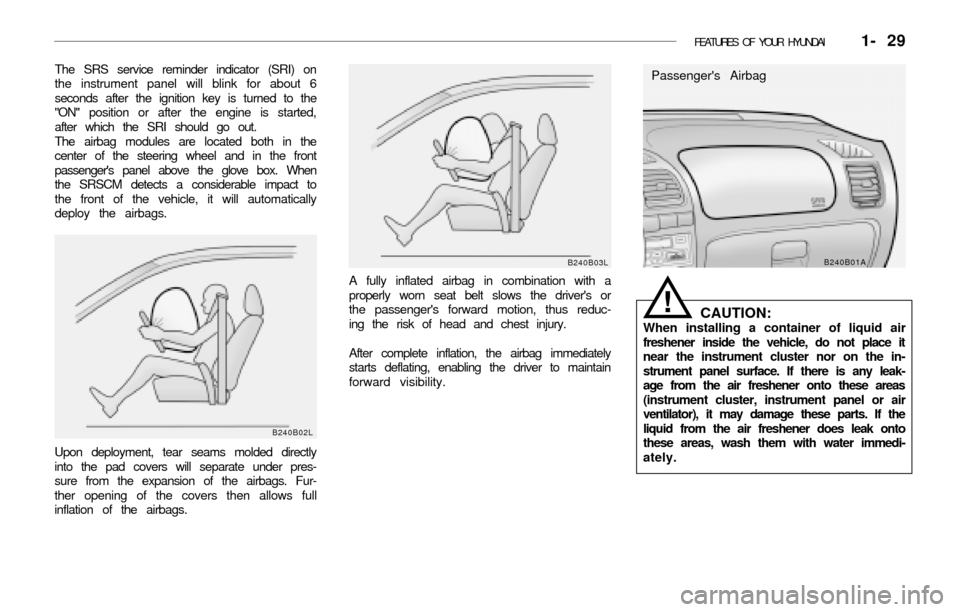
FEATURES OF YOUR HYUNDAI 1- 29
The SRS service reminder indicator (SRI) on
the instrument panel will blink for about 6
seconds after the ignition key is turned to the
"ON" position or after the engine is started,
after which the SRI should go out.
The airbag modules are located both in the
center of the steering wheel and in the front
passenger's panel above the glove box. When
the SRSCM detects a considerable impact to
the front of the vehicle, it will automatically
deploy the airbags.
A fully inflated airbag in combination with a
properly worn seat belt slows the driver's or
the passenger's forward motion, thus reduc-
ing the risk of head and chest injury.
After complete inflation, the airbag immediately
starts deflating, enabling the driver to maintain
forward visibility.
B240B02L
Upon deployment, tear seams molded directly
into the pad covers will separate under pres-
sure from the expansion of the airbags. Fur-
ther opening of the covers then allows full
inflation of the airbags.
B240B03L
CAUTION:When installing a container of liquid air
freshener inside the vehicle, do not place it
near the instrument cluster nor on the in-
strument panel surface. If there is any leak-
age from the air freshener onto these areas
(instrument cluster, instrument panel or air
ventilator), it may damage these parts. If the
liquid from the air freshener does leak onto
these areas, wash them with water immedi-
ately.
!
B240B01A
Passenger's Airbag
Page 45 of 186
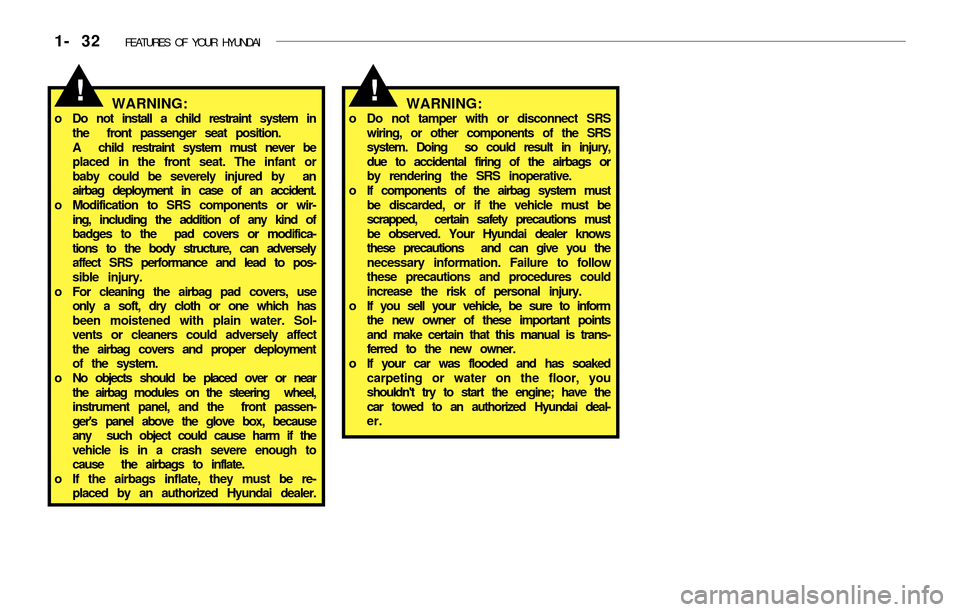
1- 32 FEATURES OF YOUR HYUNDAI
!WARNING:o Do not tamper with or disconnect SRS
wiring, or other components of the SRS
system. Doing so could result in injury,
due to accidental firing of the airbags or
by rendering the SRS inoperative.
o If components of the airbag system must
be discarded, or if the vehicle must be
scrapped, certain safety precautions must
be observed. Your Hyundai dealer knows
these precautions and can give you the
necessary information. Failure to follow
these precautions and procedures could
increase the risk of personal injury.
o If you sell your vehicle, be sure to inform
the new owner of these important points
and make certain that this manual is trans-
ferred to the new owner.
o If your car was flooded and has soaked
carpeting or water on the floor, you
shouldn't try to start the engine; have the
car towed to an authorized Hyundai deal-
er.WARNING:o Do not install a child restraint system in
the front passenger seat position.
A child restraint system must never be
placed in the front seat. The infant or
baby could be severely injured by an
airbag deployment in case of an accident.
o Modification to SRS components or wir-
ing, including the addition of any kind of
badges to the pad covers or modifica-
tions to the body structure, can adversely
affect SRS performance and lead to pos-
sible injury.
o For cleaning the airbag pad covers, use
only a soft, dry cloth or one which has
been moistened with plain water. Sol-
vents or cleaners could adversely affect
the airbag covers and proper deployment
of the system.
o No objects should be placed over or near
the airbag modules on the steering wheel,
instrument panel, and the front passen-
ger's panel above the glove box, because
any such object could cause harm if the
vehicle is in a crash severe enough to
cause the airbags to inflate.
o If the airbags inflate, they must be re-
placed by an authorized Hyundai dealer.
!
Page 60 of 186
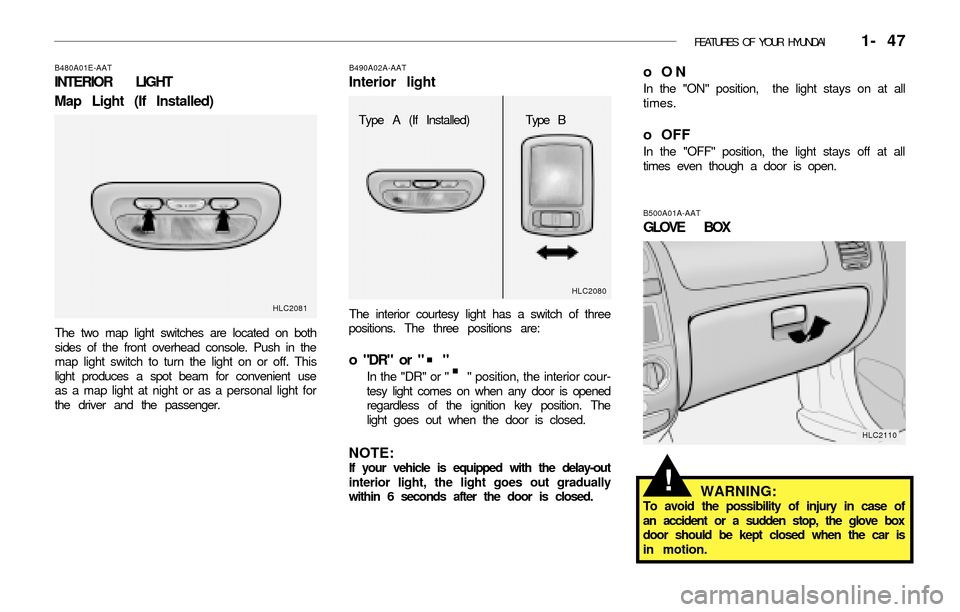
FEATURES OF YOUR HYUNDAI 1- 47
oON
In the "ON" position, the light stays on at all
times.
o OFF
In the "OFF" position, the light stays off at all
times even though a door is open.
The interior courtesy light has a switch of three
positions. The three positions are:
o "DR" or "·"
In the "DR" or "·" position, the interior cour-
tesy light comes on when any door is opened
regardless of the ignition key position. The
light goes out when the door is closed.
NOTE:If your vehicle is equipped with the delay-out
interior light, the light goes out gradually
within 6 seconds after the door is closed.
B490A02A-AAT
Interior light
HLC2080
Type A (If Installed)Type B
B480A01E-AAT
INTERIOR LIGHT
Map Light (If Installed)
The two map light switches are located on both
sides of the front overhead console. Push in the
map light switch to turn the light on or off. This
light produces a spot beam for convenient use
as a map light at night or as a personal light for
the driver and the passenger.
HLC2081
HLC2110 B500A01A-AAT
GLOVE BOX
WARNING:
To avoid the possibility of injury in case of
an accident or a sudden stop, the glove box
door should be kept closed when the car is
in motion.
!
Page 61 of 186
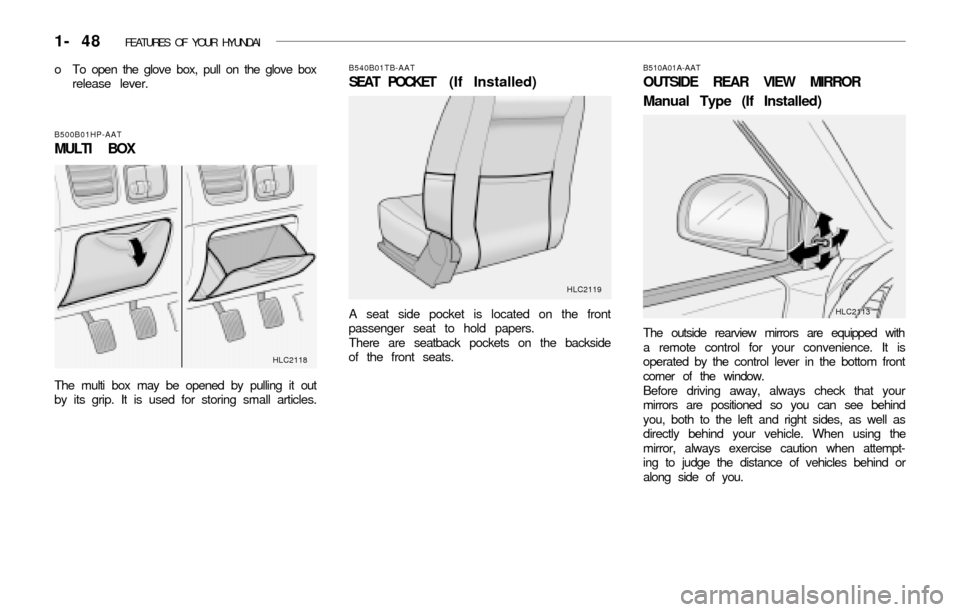
1- 48 FEATURES OF YOUR HYUNDAI
o To open the glove box, pull on the glove box
release lever.
B500B01HP-AAT
MULTI BOX
The multi box may be opened by pulling it out
by its grip. It is used for storing small articles.
HLC2118B510A01A-AAT
OUTSIDE REAR VIEW MIRROR
Manual Type (If Installed)
The outside rearview mirrors are equipped with
a remote control for your convenience. It is
operated by the control lever in the bottom front
corner of the window.
Before driving away, always check that your
mirrors are positioned so you can see behind
you, both to the left and right sides, as well as
directly behind your vehicle. When using the
mirror, always exercise caution when attempt-
ing to judge the distance of vehicles behind or
along side of you.
B540B01TB-AAT
SEAT POCKET (If Installed)
A seat side pocket is located on the front
passenger seat to hold papers.
There are seatback pockets on the backside
of the front seats.
HLC2119
HLC2113
Page 77 of 186
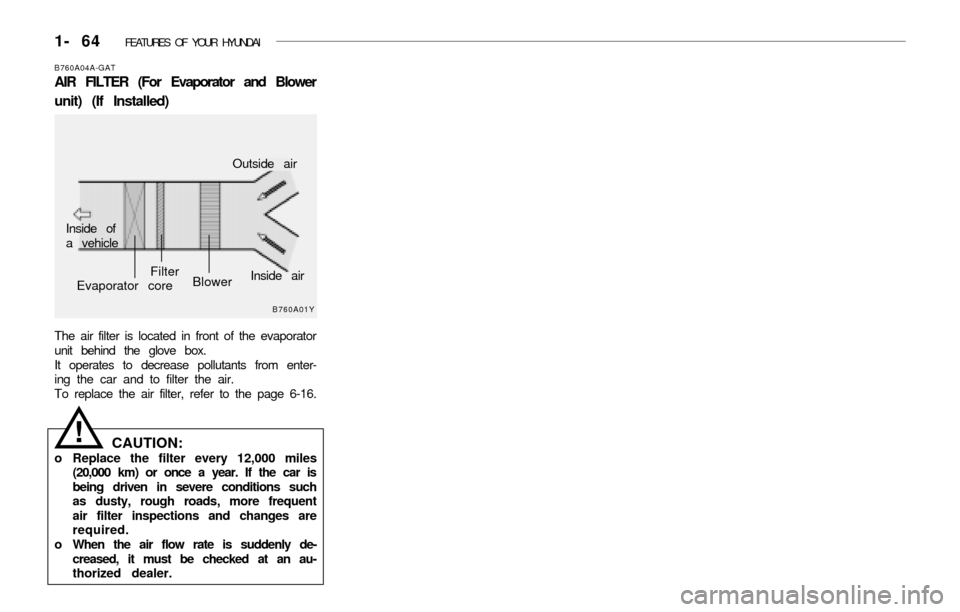
1- 64 FEATURES OF YOUR HYUNDAI
!
B760A01Y
The air filter is located in front of the evaporator
unit behind the glove box.
It operates to decrease pollutants from enter-
ing the car and to filter the air.
To replace the air filter, refer to the page 6-16.
B760A04A-GAT
AIR FILTER (For Evaporator and Blower
unit) (If Installed)
Inside of
a vehicle
Evaporator coreFilter
Blower
Outside air
CAUTION:o Replace the filter every 12,000 miles
(20,000 km) or once a year. If the car is
being driven in severe conditions such
as dusty, rough roads, more frequent
air filter inspections and changes are
required.
o When the air flow rate is suddenly de-
creased, it must be checked at an au-
thorized dealer.Inside air
Page 129 of 186
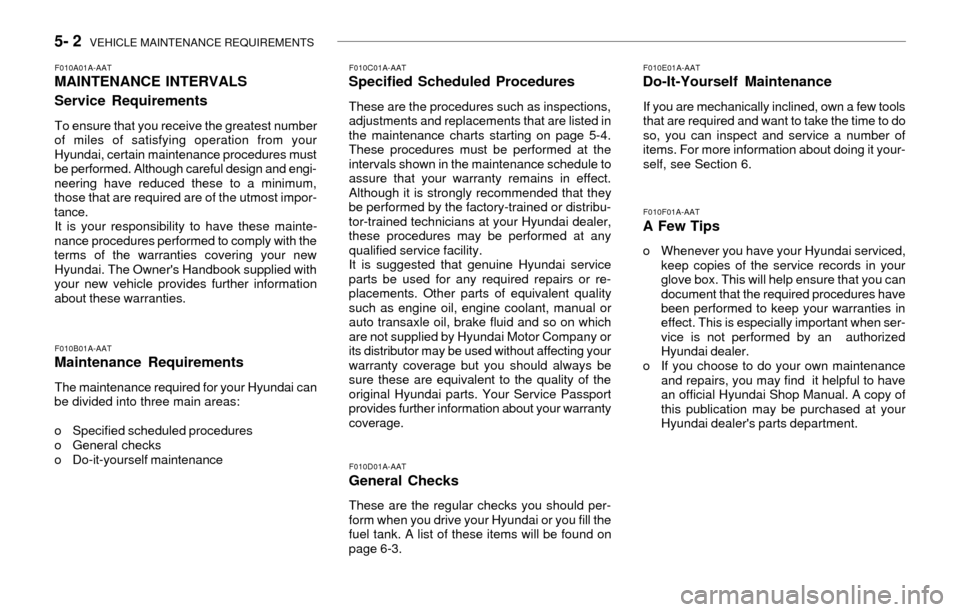
5- 2 VEHICLE MAINTENANCE REQUIREMENTS
F010B01A-AATMaintenance Requirements
The maintenance required for your Hyundai can
be divided into three main areas:
o Specified scheduled procedures
o General checks
o Do-it-yourself maintenance
F010A01A-AATMAINTENANCE INTERVALS
Service Requirements
To ensure that you receive the greatest number
of miles of satisfying operation from your
Hyundai, certain maintenance procedures must
be performed. Although careful design and engi-
neering have reduced these to a minimum,
those that are required are of the utmost impor-
tance.
It is your responsibility to have these mainte-
nance procedures performed to comply with the
terms of the warranties covering your new
Hyundai. The Owner's Handbook supplied with
your new vehicle provides further information
about these warranties.
F010D01A-AAT
General Checks
These are the regular checks you should per-
form when you drive your Hyundai or you fill the
fuel tank. A list of these items will be found on
page 6-3.
F010C01A-AATSpecified Scheduled Procedures
These are the procedures such as inspections,
adjustments and replacements that are listed in
the maintenance charts starting on page 5-4.
These procedures must be performed at the
intervals shown in the maintenance schedule to
assure that your warranty remains in effect.
Although it is strongly recommended that they
be performed by the factory-trained or distribu-
tor-trained technicians at your Hyundai dealer,
these procedures may be performed at any
qualified service facility.
It is suggested that genuine Hyundai service
parts be used for any required repairs or re-
placements. Other parts of equivalent quality
such as engine oil, engine coolant, manual or
auto transaxle oil, brake fluid and so on which
are not supplied by Hyundai Motor Company or
its distributor may be used without affecting your
warranty coverage but you should always be
sure these are equivalent to the quality of the
original Hyundai parts. Your Service Passport
provides further information about your warranty
coverage.
F010F01A-AATA Few Tips
o Whenever you have your Hyundai serviced,
keep copies of the service records in your
glove box. This will help ensure that you can
document that the required procedures have
been performed to keep your warranties in
effect. This is especially important when ser-
vice is not performed by an authorized
Hyundai dealer.
o If you choose to do your own maintenance
and repairs, you may find it helpful to have
an official Hyundai Shop Manual. A copy of
this publication may be purchased at your
Hyundai dealer's parts department.
F010E01A-AATDo-It-Yourself Maintenance
If you are mechanically inclined, own a few tools
that are required and want to take the time to do
so, you can inspect and service a number of
items. For more information about doing it your-
self, see Section 6.